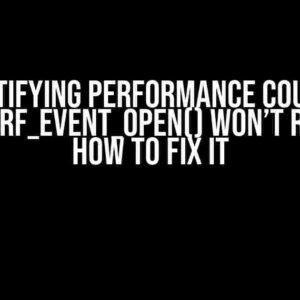If you’re reading this, chances are you’ve found yourself stuck in an infinite loop, wondering why you can’t seem to escape the never-ending cycle of code execution. Don’t worry, you’re not alone! Infinite loops can be frustrating, but with the right guidance, you can break free from their grasp.
What is an Infinite Loop?
Before we dive into the solutions, let’s take a step back and understand what an infinite loop is. An infinite loop is a sequence of code that continues to execute indefinitely, either due to a logical error or intentional design. There are two types of infinite loops:
- Intentional Infinite Loop: Used in situations where a program needs to continuously perform a task, such as monitoring system resources or handling user input.
- Unintentional Infinite Loop: Caused by errors in code logic, leading to an infinite sequence of executions.
Why Can’t I Exit an Infinite Loop?
In most cases, infinite loops occur due to one of the following reasons:
- Incorrect Loop Conditions: The loop’s termination condition is not properly defined, causing the loop to continue indefinitely.
- Misunderstanding of Loop Control Statements: Misusing control statements like
break,continue, orreturncan lead to infinite loops. - Recursive Function Calls: Recursive functions without a proper termination condition can lead to infinite loops.
- Logical Errors: Errors in code logic can cause an infinite loop, such as forgetting to increment a counter or checking for the wrong condition.
Symptoms of an Infinite Loop
If you’re experiencing any of the following symptoms, you might be stuck in an infinite loop:
- Program Hangs or Freezes: Your program or browser becomes unresponsive, and you’re unable to interact with it.
- High CPU Usage: Your CPU usage skyrockets, indicating an infinite loop.
- Infinite Output: Your program prints an endless stream of output, filling your console or screen.
- Memory Leaks: Infinite loops can cause memory leaks, leading to performance issues and crashes.
How to Identify an Infinite Loop
To identify an infinite loop, follow these steps:
- Check the Loop Conditions: Review the loop’s termination condition and ensure it’s properly defined.
- Use Debugging Tools: Utilize debugging tools like print statements, console logs, or a debugger to identify the loop’s execution path.
- Analyze the Code Flow: Study the code flow and identify where the loop might be getting stuck.
Breaking the Loop: Solutions and Strategies
Now that we’ve identified the issue, it’s time to break free from the infinite loop. Here are some solutions and strategies to help you exit:
1. Review and Refactor the Loop Conditions
Double-check the loop’s termination condition and ensure it’s correctly defined. Ask yourself:
- Is the loop condition properly defined?
- Is the loop incrementing or decrementing correctly?
- Are there any edge cases that might be causing the loop to stuck?
// Example of an infinite loop due to incorrect loop conditions
while (true) {
// code here
}
// Refactored loop with a correct termination condition
int i = 0;
while (i < 10) {
// code here
i++; // increment the counter
}
2. Use Control Statements Wisely
Make sure you're using control statements like break, continue, and return correctly:
break: Exits the loop immediately.continue: Skips the current iteration and continues with the next one.return: Exits the function and returns control to the calling function.
// Example of using break to exit an infinite loop
while (true) {
if (someCondition) {
break; // exit the loop
}
// code here
}
3. Avoid Recursive Function Calls
Make sure recursive functions have a proper termination condition to avoid infinite loops:
// Example of an infinite recursive function
function recursiveFunction() {
recursiveFunction(); // no termination condition
}
// Refactored recursive function with a termination condition
function recursiveFunction(count) {
if (count > 10) {
return; // terminate the recursion
}
recursiveFunction(count + 1); // recurse with incremented count
}
4. Log and Debug Your Code
Use logging and debugging tools to identify the loop's execution path and pinpoint the issue:
// Example of using console logs to debug an infinite loop
while (true) {
console.log("Loop iteration:", i);
if (someCondition) {
break; // exit the loop
}
i++; // increment the counter
}
5. Implement a Timeout or Max Iterations
In some cases, you can implement a timeout or a maximum number of iterations to prevent infinite loops:
// Example of using a timeout to exit an infinite loop
let timeout = 5000; // 5 seconds
let startTime = Date.now();
while (true) {
if (Date.now() - startTime > timeout) {
break; // exit the loop after 5 seconds
}
// code here
}
Best Practices to Avoid Infinite Loops
To avoid getting stuck in infinite loops, follow these best practices:
- Test Your Code Thoroughly: Test your code with various input scenarios to identify potential infinite loops.
- Use Code Reviews: Have a peer review your code to catch potential errors and infinite loops.
- Keep Your Code Modular: Break down complex code into smaller, manageable chunks to reduce the likelihood of infinite loops.
- Use Debugging Tools: Familiarize yourself with debugging tools and techniques to quickly identify and fix infinite loops.
Conclusion
Infinite loops can be frustrating, but with the right strategies and solutions, you can break free from their grasp. Remember to review your loop conditions, use control statements wisely, and debug your code thoroughly. By following these best practices, you'll be well-equipped to handle infinite loops and write more efficient, error-free code.
| Infinite Loop Scenario | Solution |
|---|---|
| Incorrect Loop Conditions | Review and refactor the loop conditions |
| Misused Control Statements | Use control statements wisely |
| Recursive Function Calls | Avoid recursive function calls or add a termination condition |
| Logical Errors | Log and debug your code to identify the issue |
By mastering the techniques outlined in this article, you'll be able to identify and fix infinite loops with ease. Happy coding!
Here are 5 questions and answers about "Infinite loop why can't I exit?" with a creative voice and tone:
Frequently Asked Question
Stuck in the loop? We got you covered! Here are some answers to your most pressing questions about those pesky infinite loops.
Why does my program keep running and never stop?
This is usually because of an infinite loop, where the loop condition never becomes false, so the loop keeps running indefinitely. It's like being stuck in a never-ending party – sounds fun, but not for your program!
How do I identify an infinite loop in my code?
Look for loops that don't have a clear termination condition or increment/decrement operations. Also, check for loops that depend on a variable that doesn't change within the loop. And, of course, if you see your program running for an eternity, that's a pretty good sign of an infinite loop too!
Can I use a break statement to exit an infinite loop?
Yes, you can use a break statement to exit a loop. However, if the loop is truly infinite, the break statement won't be reached because the loop condition is always true. In that case, you'll need to refactor your code to make the loop terminate normally.
Why does my program crash or freeze when I have an infinite loop?
An infinite loop can cause a program to consume all available system resources, leading to a crash or freeze. This is because the loop keeps executing repeatedly, allocating memory and CPU cycles without releasing them. It's like a toddler playing with playdough – they just keep going and going until they exhaust all the resources!
How can I prevent infinite loops in my code?
To prevent infinite loops, make sure your loops have a clear termination condition and that the loop variables are updated correctly within the loop. You can also use debugging tools to identify infinite loops and test your code thoroughly before deploying it. And, of course, always keep an eye out for those sneaky infinite loops – they can appear when you least expect it!


